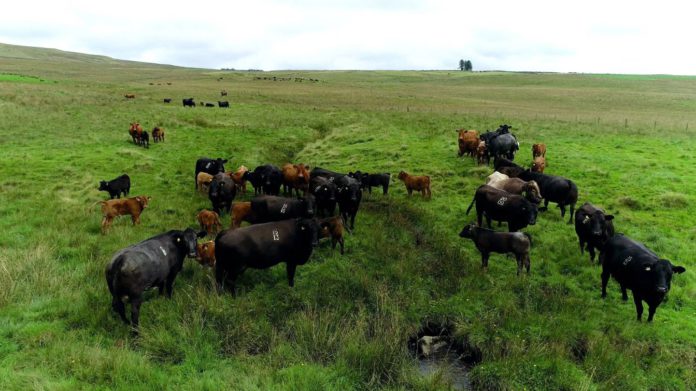The CAFRE Hill Farm is the result of integrating environmental and livestock management since 1963.
The enterprise in the district of Glenwherry in the Antrim Hills between Ballymena and Larne is partially situated within the Antrim Hills Special Protection Area (SPA) for Hen Harrier and Merlin.
CAFRE Hill Farm
The Hill Farm Centre spans almost 1,000 hectares and has 100 suckler cows and 1,100 breeding ewes.
In Northern Ireland’s Centenary Year, CAFRE staff have been reflecting on the farm’s history.
In 1963, the Department of Agriculture, Environment and Rural Affairs purchased the Hill Farm from the Antrim Estates Company for £39,100. It acquired the farm for demonstration and training purposes.
Over the years, the Northern Ireland agriculture industry has evolved, and environmental policies have changed.
However, one constant has been the Hill Farm’s role in supporting students, farmers and upland land managers to develop innovative practices.
Historical maps show that the field and hill pattern has remained similar over the years. However, in the early 20th century, the moorland landscape was very open, with very few drains marked.
From 1950 through to 1980, forestation blocks and open drainage systems were installed throughout the moorland.
This changed dramatically in 2019 when 60 hectares of forestry was felled. Now, for the first time since the 1980s, the upper moor “looks totally open”.

Environmental management and wildlife regeneration
In 2009, the focus of the Hill Farm broadened to emphasise environmental management and wildlife regeneration.
Also, at this time came the launch of the Glenwherry Hill Regeneration Partnership Project.
This project involves CAFRE collaborating in a partnership with the Irish Grouse Conservation Trust and the Royal Society for the Protection of Birds (RSPB).
Advisory representatives from the following bodies also contribute:
- Northern Ireland Raptor Study Group (NIRSG);
- The Northern Ireland Environment Agency (NIEA);
- Queens University Belfast (QUB);
- Agri-Food Biosciences Institute (AFBI).
Predator control and habitat management
CAFRE states that through predator control and habitat management, this project has successfully achieved some of the highest population densities in Ireland for red grouse and Irish hare.
It has seen a steady increase in breeding waders and continued growth foraging presence of hen harrier.
“There has been a notable return of curlew and lapwing which have successfully bred and fledged young.”
“Remarkably, this has all been achieved, whilst simultaneously maintaining a viable upland farming enterprise with no impact on beef and sheep performance.”
In 2020, the emphasis widened to focus on all the Hill Farm ecosystem services.
These include food production, biodiversity, flood alleviation, carbon storage, carbon sequestration and water quality.
The peatland is a catchment for the nearby Killylane Reservoir, which serves 60,000 people from Larne to Ballymena.
CAFRE is maximising water quality and carbon storage by a 60-hectare Forest-to-Bog project and open moor rewetting works.
CAFRE states that “crucial” to the farm’s environmental management is the integration of livestock.
Suckler farm
The original herd in 1965 comprised 50 Blue-Grey cows, the offspring from a Shorthorn bull and a Galloway cow.
Since 2002, the CAFRE Hill Farm herd has three breeds in the genetic pool: Aberdeen Angus, Limousin and Shorthorn.
It based the herd’s establishment on science indicating that the three breeds would “deliver the maximum genetic boost possible to performance, primarily through better fertility and survival”.
Sheep farm
On the other hand, half the flock comprises Blackface ewes. The reed that can survive and rear lambs in a hill environment.
Their foraging habits have evolved in line with the environment, and their existence ensures good habitat management.
Furthermore, in 2016, it constructed a state-of-the-art sheep house at the hill farm.
Since then, it has made an additional investment in breeding programmes and data recording packages, integrating innovative health management protocols and labour utilisation technologies.
Each year, the farm welcomes hundreds of visitors and is of interest to students and farmers alike.
Further reading
Read more articles from CAFRE.
To share your story, email – [email protected]





